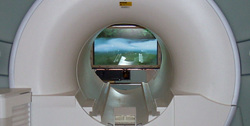The first day of testing I found myself confronted with a potential Tube (subway) strike, so I decided to walk over to the facilities. It was a bit of a hike, so I didn't get there as early as I would've liked. By the time I filled out the forms, the researchers immediately started me with the hearing tests so that we didn't miss our scheduled time-slot for the fMRI. I was brought into a small room with a table, chair, and computer monitor. The walls, floor, and ceiling were covered with warm gray fabric, I assume to lessen any extraneous sounds. The researchers put sensors on my fingers, another sensor band around my diaphragm and then gave me a little four-button device to rank the sounds that I heard ("1" for no annoyance, "4" for the most annoyance.) They had me listen to a series of everyday sounds - each sound playing for about 3-5 seconds, during which time I had to focus my attention on a plus symbol in the middle of the screen. In the pause between sound bytes, the screen asked me to first rank how annoying the sound was and then asked how much that particular sound triggered my misophonia. There is a difference! Some sounds were very annoying but didn't trigger my misophonia. Other sounds triggered my misophonia big time! A few sounds didn't bother me at all. This went on for about 10-12 minutes, after which time one of the researchers would pop into the room to make sure I was okay. After about five sessions of the 10-12 minute series of sound bytes, the researchers unhooked me from all the sensors and then we went over to the fMRI.
 (Image from http://www.sfnic.ucsf.edu website.)
(Image from http://www.sfnic.ucsf.edu website.) The scan itself wasn't bad, probably since I've had scans like that before. At times though, I tried to figure out what the MRI noises sounded like - one reminded me of the fast beeping sound I'd hear if something the computer was warning me that I left something on top of my keyboard. Once the scans were over, that day's tasks were done. I left the facilities with one of the researchers, who also has misophonia, and we had a lovely conversation over coffee around the corner. We exchanged misophonia experiences and thoughts about where research needs to go. We talked about how our misophonia affected our relationships with family and others. It was nice to speak with someone who not only understands what I'm going through, but is also working towards a better scientific understanding of the condition.
I'm sure that anyone participating in the study probably felt the same desire to be able to brave through the discomfort so we could provide good data about misophonia for the researchers. From what I understand, someone before me was in tears from some of the sounds, and even though she wanted to continue with the testing, the researchers wouldn't let her because they felt it would be morally wrong for her to be subjected to sounds that were clearly making her miserable. That's what impressed me so much about this research study. The researchers made sure participants understood that we could stop at ANY point during the testing process and even though we might want to push ourselves to be exposed to trigger sounds, even if we didn't say "STOP!" the researchers monitored our vitals and made sure that we weren't hurting ourselves.
After the testing was done and I was disconnected from all the wires and gadgets, I went into the control room to talk with the researcher. He commented that I was able to provide them with some good data. (Yay! I did my part.) I noticed a bar-graph on one of the monitors in the room, which the researcher pointed out were my 1-4 button responses to the series of sounds I heard. As far as the correlation of sounds to the brain scans, he said that after they completed testing all the participants (both misophonia sufferers and the "non-sufferer" control group), then they'd analyze all the collected data. It sounded like it would take a long time to go through all the data, but I'm hopeful that they'll be able to formulate some conclusions by the early Fall. I can't wait to read the whitepaper of the study when it comes out!
 RSS Feed
RSS Feed
